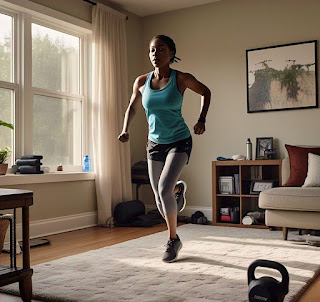High-Intensity Interval Training for Beginners at Home: A Comprehensive Guide
High-Intensity Interval Training for Beginners at Home
Introduction
In today’s fast-paced world, staying fit and healthy is more
important than ever. However, not everyone has the time or resources to hit the
gym regularly. Enter High-Intensity Interval Training (HIIT) — a quick,
effective workout solution that you can do right in the comfort of your home.
Whether you’re looking to improve your cardiovascular health, boost your
metabolism, or simply find a fitness routine that fits your busy schedule, HIIT
might be the perfect fit for you. This guide will walk you through everything
you need to know about getting started with HIIT at home.
What is High-Intensity Interval Training (HIIT)?
HIIT is a workout method that alternates between short
bursts of intense activity and periods of lower-intensity exercise or rest. For
instance, you might sprint for 30 seconds and then walk for a minute, repeating
the cycle several times. The goal is to push your body to its limits during the
high-intensity intervals, followed by recovery periods to prepare for the next
burst of activity. This format is not only efficient but also highly effective
for burning calories and improving overall fitness.
Why Choose HIIT at Home?
HIIT is an excellent option for beginners and experienced
fitness enthusiasts alike. Here are a few reasons why HIIT works so well as a
home workout:
- Time-Efficient:
Most HIIT sessions last anywhere from 15 to 30 minutes, making them
perfect for those with tight schedules.
- No
Equipment Needed: Many HIIT exercises rely on body weight, eliminating
the need for costly gym equipment.
- Customizable:
You can adjust the intensity and duration of intervals to suit your
fitness level.
- Space-Friendly:
All you need is a small, open area to get started.
Benefits of HIIT
1. Improves Cardiovascular Health
HIIT challenges your heart and lungs, improving
cardiovascular endurance over time. This is particularly beneficial for
beginners looking to build stamina quickly.
2. Boosts Metabolism
HIIT workouts create an "afterburn effect" (excess
post-exercise oxygen consumption), allowing your body to continue burning
calories even after you’ve finished your workout.
3. Builds Muscle Strength
Bodyweight exercises like squats, push-ups, and burpees help
strengthen various muscle groups without the need for weights.
4. Enhances Mental Well-being
The endorphins released during HIIT can help reduce stress,
improve mood, and boost overall mental health.
Beginner-Friendly HIIT Workouts
Workout #1: Full-Body HIIT (15 minutes)
- Jumping
Jacks: 30 seconds (High-intensity)
- Rest:
15 seconds
- Bodyweight
Squats: 30 seconds (High-intensity)
- Rest:
15 seconds
- Push-Ups:
30 seconds (High-intensity, modify to knees if needed)
- Rest:
15 seconds
- High
Knees: 30 seconds (High-intensity)
- Rest:
15 seconds
Repeat the circuit 2-3 times.
Workout #2: Cardio-Focused HIIT (20 minutes)
- Mountain
Climbers: 40 seconds
- Rest:
20 seconds
- Burpees:
40 seconds
- Rest:
20 seconds
- Skater
Jumps: 40 seconds
- Rest:
20 seconds
Repeat the circuit 3 times.
Tips for a Successful HIIT Routine
- Warm-Up
First: Spend 5-10 minutes warming up to prevent injuries and prepare
your body for high-intensity exercise.
- Listen
to Your Body: It’s normal to feel challenged, but avoid pushing
yourself to the point of pain or extreme discomfort.
- Stay
Consistent: Aim for 2-3 HIIT sessions per week, gradually increasing
intensity as you build endurance.
- Stay
Hydrated: Drink water before, during, and after your workout to stay
hydrated.
- Track
Your Progress: Use a fitness app or journal to track your intervals,
progress, and goals.
Common Mistakes to Avoid
- Skipping
Warm-Ups and Cool-Downs: These are essential for preventing injuries
and aiding recovery.
- Poor
Form: Prioritize proper technique over speed to avoid strain and
maximize results.
- Overtraining:
Give your body time to rest and recover between sessions.
- Ignoring
Nutrition: Pair your workouts with a balanced diet to see the best
results.
Optimizing Your At-Home Setup
- Choose
a Dedicated Space: Clear an area free of obstacles to minimize
distractions and ensure safety.
- Wear
Comfortable Clothing: Opt for breathable, moisture-wicking fabrics and
supportive shoes.
- Music
or Timer: Use an interval timer app or play upbeat music to stay
motivated and on track.
Final Steps
High-Intensity Interval Training is a game-changer for
anyone looking to improve their fitness without spending hours at the gym. Its
flexibility, efficiency, and effectiveness make it an ideal choice for
beginners and seasoned athletes alike. Start small, stay consistent, and
remember to celebrate your progress along the way.
Ready to take the first step? Lace up your sneakers, find a
clear space at home, and try one of the beginner-friendly workouts from this
guide. Your fitness journey starts today!





